
Goodenia ovata, commonly called the hop goodenia, is a species of flowering plant and is endemic to south-eastern Australia. It is a shrub with sticky, often varnished foliage, toothed egg-shaped to elliptic leaves and racemes or thyrses of yellow flowers.

Goodenia hederacea, commonly known as forest goodenia or ivy goodenia, is a species of flowering plant that is endemic to eastern Australia. It is a prostrate to ascending, perennial herb with linear to elliptic or round leaves, and racemes of yellow flowers.
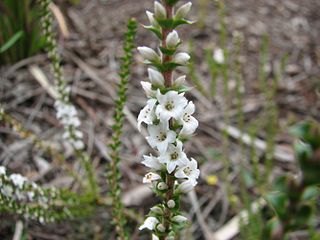
Epacris gunnii is a species of flowering plant in the family Ericaceae and is endemic to south-eastern Australia. It is an erect shrub with hairy branchlets, concave, sharply-pointed, broadly egg-shaped leaves, and tube-shaped, white flowers arranged along the stems.

Goodenia paradoxa, commonly known as spur velleia or spur goodenia, is a species of flowering plant in the family Goodeniaceae, and is endemic to Australia. It is a perennial herb covered with soft hairs, and has egg-shaped to elliptic leaves with toothed edges and yellow flowers on an ascending flowering stem.

Goodenia caroliniana is a species of flowering plant in the family Goodeniaceae, and is endemic to eastern Australia. It is a perennial herb with egg-shaped to lance-shaped leaves with toothed edges and the narrower end toward the base, and erect flowering stems up to 50 cm (20 in) high and yellow flowers.

Goodenia connata, commonly known as cup velleia, is a species of flowering plant in the family Goodeniaceae, and is found in all mainland states and territories of Australia. It is a glabrous annual herb with a rosette of leaves at the base, and ascending flowering stems with yellow, brownish-yellow or white flowers, often with mauve markings.
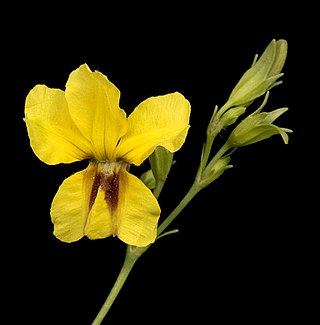
Goodenia macrophylla, or large-leaved velleia, is a species of flowering plant in the family Goodeniaceae, and is endemic to the south-west of Western Australia. It is a glabrous perennial plant with egg-shaped to elliptic leaves with toothed edges, and yellow flowers.
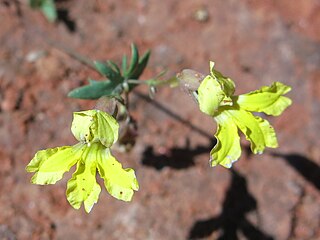
Goodenia glabrata, commonly known as pee the bed, is a species of flowering plant in the family Goodeniaceae and is native to mainland Australia. It is a mostly glabrous annual herb with ascending flowering stems, oblong to lance-shaped leaves with toothed edges, and yellow flowers.

Goodenia heterophylla is a species of plant in the family Goodeniaceae and is endemic to eastern Australia. It is an erect to trailing, more or less woody herb or shrub with linear to egg-shaped stem-leaves and racemes or thyrses of yellow flowers.

Goodenia blackiana, commonly known as Black's goodenia, is a species of flowering plant in the family Goodeniaceae and is endemic to southern Australia. It is a herb with egg-shaped to lance-shaped leaves with the narrower end towards the base, and racemes of yellow flowers.
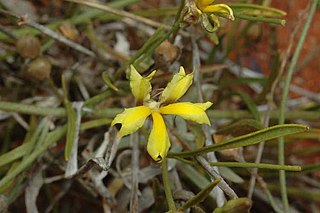
Goodenia fascicularis, commonly known as silky goodenia, is a species of flowering plant in the family Goodeniaceae and is widely distributed in eastern continental Australia. It is an ascending perennial herb with linear to egg-shaped leaves and racemes of yellow flowers.

Goodenia humilis, commonly known as swamp goodenia, is a species of flowering plant in the family Goodeniaceae and is endemic to south-eastern Australia. It is a weak, perennial herb with linear to lance-shaped leaves mostly at the base of the plant, and racemes or thyrses of yellow or yellowish-brown flowers.
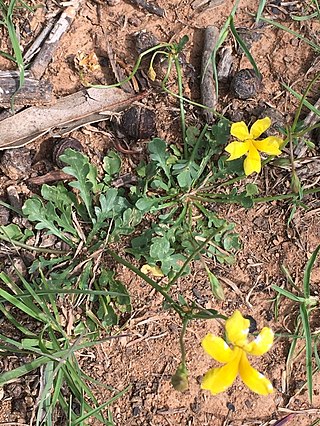
Goodenia pinnatifida, commonly known as cut-leaf goodenia, scrambled eggs or mother ducks, is a species of flowering plant in the family Goodeniaceae and endemic to Australia. It is a low-lying to ascending perennial herb with toothed to pinnatisect leaves, racemes of yellow flowers and more or less spherical fruit.

Goodenia mystrophylla is a flowering plant in the family Goodeniaceae and is native to eastern Australia and New Guinea. It is a small, perennial herb with lance-shaped leaves, prostrate or low-lying flower stems and yellow flowers with purplish markings.

Goodenia arguta, commonly known as spur velleia, or grassland goodenia, is a species of flowering plant in the family Goodeniaceae and endemic to continental Australia. It is a glabrous perennial with a rosette of leaves at the base of the plant and ascending flowering stems with deep yellow flowers.

Goodenia daviesii, commonly known as hairy velleia, is a species of flowering plant in the Goodeniaceae family and is endemic to inland areas of Western Australia. It is an annual herb with lyre-shaped, pinnatifid leaves and lilac to white flowers.

Goodenia brendannarum is a species of flowering plant in the family Goodeniaceae, and is endemic to a small area in the south-west of Western Australia. It is a perennial herb with woody stems, crowded, narrowly egg-shaped leaves with toothed edges, and erect flowering stems and orange-yellow and red flowers.
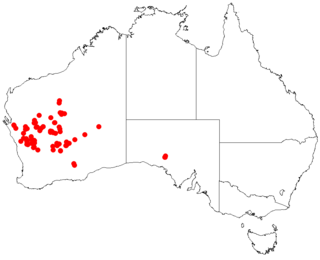
Goodenia capillosa, commonly known as hispid velleia, is a species of flowering plant in the family Goodeniaceae and is native to inland areas of Western Australia and South Australia. It is an annual herb with covered with soft hairs, and has narrowly egg-shaped to narrowly elliptic leaves with toothed or lyre-shaped edges, and yellow flowers.

Goodenia macrocalyx is a species of flowering plant in the family Goodeniaceae and is endemic to north-western Australia. It is a glabrous, perennial herb with elliptic to narrowly egg-shaped leaves at the base of the plant, yellow flowers and narrowly oval fruit.

Goodenia panduriformis, commonly known as Pindan poison, is a species of flowering plant in the family Goodeniaceae and is endemic to north-western Australia. It is a glaucous herb with erect flower stems, glabrous, toothed, egg-shaped leaves with the narrower end towards the base, bracteoles joined to form a large disc, and deep- or brownish-yellow flowers.





















